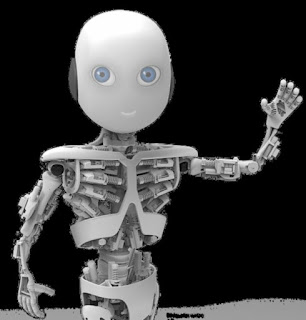 |
| An artist impression of Roboy Images and story from Daily Mail |
 |
| Engineers behind roboy |
Scientists have revealed an ambitious plan to create a
humanoid helper robot with artificial muscles - in just nine months.
Engineers at the University of Zurich's Artificial
Intelligence Lab hope that 1.2m tall Roboy, designed to look like a child, will
eventually help the sick and elderly by acting as a mechanical helper.
To help the robot move, the team are developing radical
artificial 'tendons'.
Roboy will have a skeleton similar to a human's and will
be operated via special artificial tendons that flex like our own muscles.
The team has already signed up 15 project partners and
over 40 engineers, and hope to fund the project using a combination of
commercial partners and crowdfunding.
'Financing the project through sponsorship and crowd
funding enables us to implement an extremely ambitious project in an academic
environment", said Professor Rolf Pfeifer, who is leading the project.
The team hope Roboy will become a blueprint for 'service
robots' that work alongside humans.
'Service robots
are machines that are, to a certain extent, able to execute services
independently for the convenience of human beings,' the researchers say.
'Since they share their 'living space' with people,
userfriendliness and safety are of great importance'.
'Thanks to his construction as a tendon-driven robot
modelled on human beings ('normal' robots have their motors in their joints),
Roboy moves almost as elegantly as a human,' the team claim.
'Our aging population is making it necessary to keep
older people as autonomous as possible for as long as possible, which means
caring for aged people is likely to be an important area for the deployment of
service robots.
'We can very safely assume that service robots will
become part of our environment in the future, as is already the case today for
technologies such as smartphones and laptops.'
The team is already developing parts of the Roboy, such
as its skeleton like chest which houses spring-like artificial tendons.
Work has also begun on Roboy's hands, which will be
covered with a soft 'skin' to make it comfortable to the touch.
'Creating humanoid robots presents researchers with great
challenges,' the researchers say.
'Elements such as quick, smooth movements or robust, flexible yet soft skin are difficult to recreate.
'Fundamental new findings are needed for this purpose.
It is precisely through projects like Roboy that
innovation is possible.'
Roboy is expected to be 'born' in March 2013, when it will be unveiled at the Robots on Tour event in Zurich.
The lab is seeking donations to fund the work,and is offering to put a logo on the machine for £34,000 ($55,000).
2 comments:
How soon before these oyinbos make complete human being?
This project is incredible as they are emulating the actual function of tendons to create this robot. The possibilities to help people are also amazing.
Post a Comment